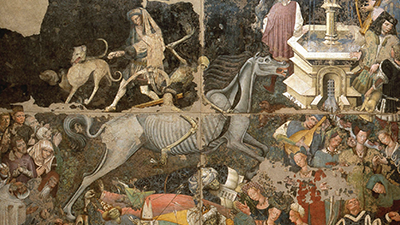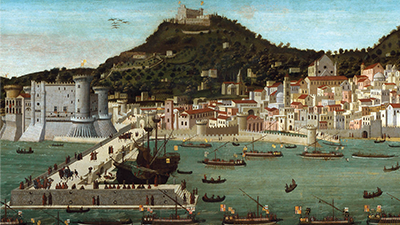Assessing the Dark Ages
Teacher Resources
Driving Question: Did Europe go through a dark age after the fall of the Roman Empire?
When historians call this period the “Dark Ages,” they’re usually talking about Europe. And that’s where we’ll start—but there’s a big world beyond Europe. We’ll try to figure out if the medieval period in Europe was really a dark age and evaluate how other societies around the world responded to collapse.
Learning Objectives:
- Analyze the extent to which Europe experienced a period of societal collapse following the fall of the Roman Empire.
- Evaluate historical debates surrounding the Dark Ages in Europe and beyond.
Vocab Terms:
- administrative
- aristocracy
- bureaucrat
- clergy
- feudalism
- pluralism
- province
Opener: Assessing the Dark Ages
To teach this lesson step, refer to page 2 of the Lesson 5.3 Teaching Guide.
Thinking about how the Dark Ages were labeled? Take a look at Rebranding the "Dark Ages" in the community forum.
You’ve heard the term Dark Ages before, but what does it mean? Was it truly dark, or is the story more complicated?
Dark Ages?
To teach this lesson step, refer to page 2 of the Lesson 5.3 Teaching Guide.
Take a look at the Reading Overview for support as students dig into these articles.
Use the Claim Testing One Pager to help support students in evaluating the evidence in this lesson step.
Evaluate the evidence you’ve encountered in this lesson and take sides in the debates about the Dark Ages.
-
Guiding Questions
-
Before you read
Preview the questions below, and then skim the article. Be sure to look at the section headings and any images.
While you read
Look for answers to these questions:
- Who first described Europe after the fall of Rome as being “dark,” or backward?
- What was Edward Gibbon’s contribution to the idea of a “dark age?”
- How might English Heritage’s description of Tintagel Castle provide evidence against the idea of a “dark age”?
- What does Alban Gautier think of the term Dark Ages?
- How were the views of eighteenth-century authors such as Edward Gibbon shaped by the times they lived in?
After you read
Respond to this question: Can you think of any ways that people today might use the idea of a dark age (or golden age) to suit their own agendas?
-
Guiding Questions
-
Before you read
Preview the questions below, and then skim the article. Be sure to look at the section headings and any images.
While you read
Look for answers to these questions:
- What were the political effects of the fall of the Western Roman Empire?
- What intellectual achievements occurred during the medieval period?
- How do cities provide evidence that medieval Europe wasn’t experiencing a dark age?
- Did China have a dark age?
- How did the Afro-Eurasian population change from 476 to 1176 CE?
After you read
Respond to these questions: Do you think labeling the medieval period a “dark age” is useful or accurate? Why or why not?
Closer: Assessing the Dark Ages
To teach this lesson step, refer to page 5 of the Lesson 5.3 Teaching Guide.
Looking to support students in claim writing? Take a look at this Claim and Focus activity to help scaffold this process.
You’ve learned about debates surrounding the so-called Dark Ages. In this activity, it’s your turn to weigh in—did Europe experience a dark Age after the fall of Rome?





